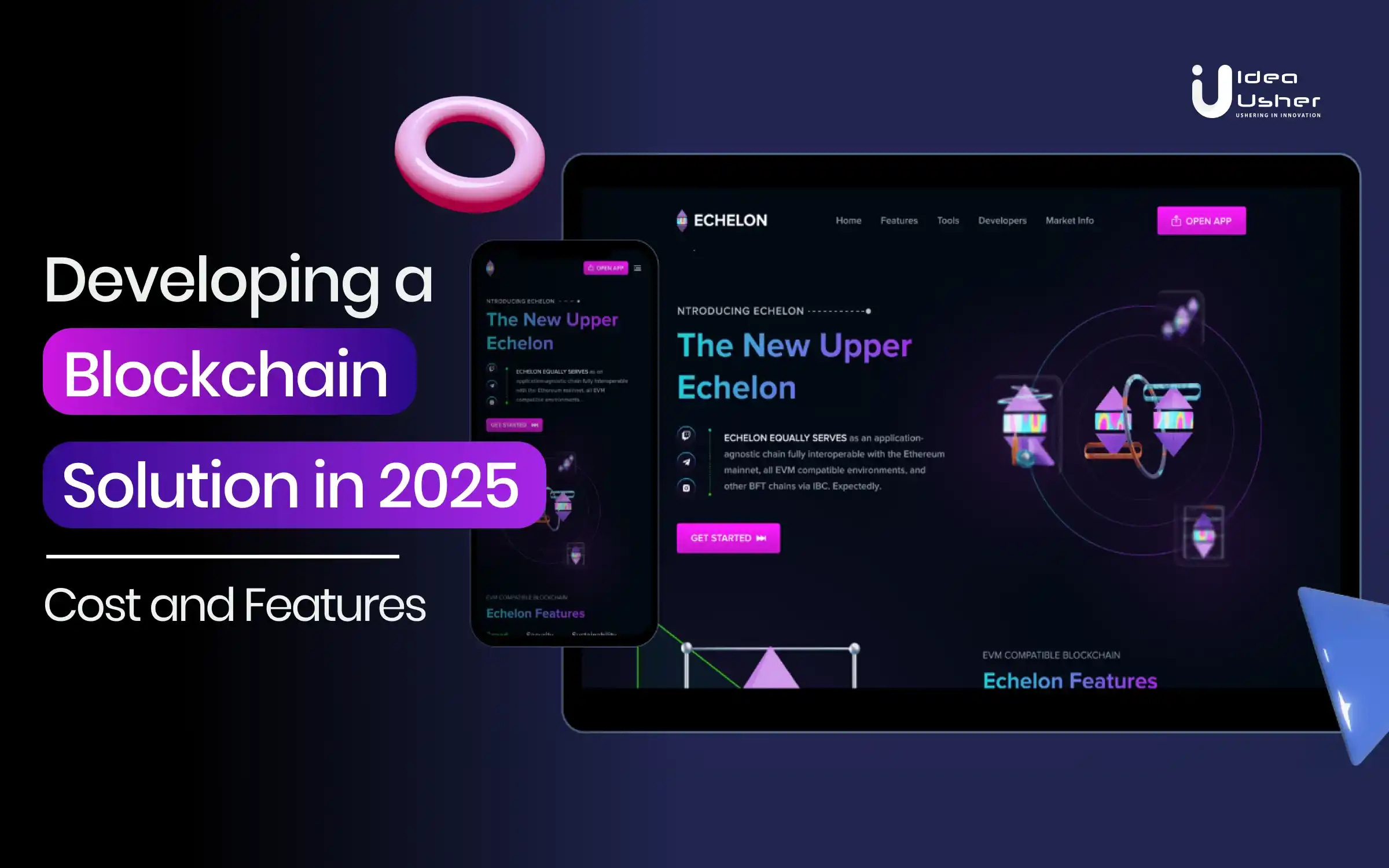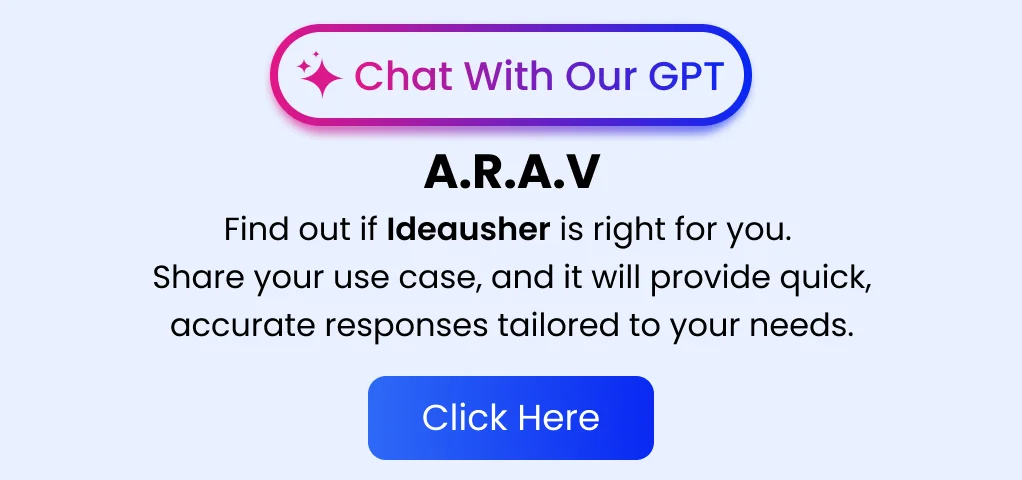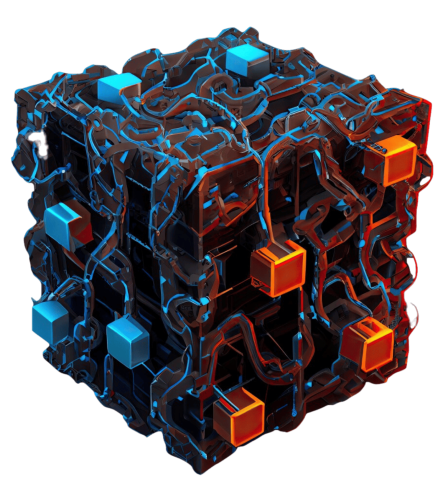Blockchain technology in 2025 continues transforming industries, offering unparalleled transparency, security, and efficiency. From supply chain management to financial services, custom blockchain solutions have become a cornerstone for businesses looking to enhance operations and gain a competitive edge. The growing demand for tailored blockchain solutions reflects the technology’s potential to address unique challenges across various sectors.
The global blockchain market is projected to reach $1.43 trillion by 2030, driven by innovations in decentralized applications and enterprise solutions. This blog will explore the key features and benefits of developing a blockchain solution tailored to your business needs in 2025. It will provide a comprehensive breakdown of the development process, essential features to consider, and a detailed cost analysis to help you budget effectively. Whether you’re a startup or an established enterprise, this guide will equip you with the insights needed to leverage blockchain technology for operational excellence and long-term growth.
Key Market Takeaways of Blockchain Technology
Grand View Research reports that the global blockchain technology market was valued at USD 17.46 billion in 2023 and is projected to grow at a CAGR of 87.7% from 2023 to 2030. Companies in various sectors are progressively adopting blockchain solutions to improve security and transparency in their operations.
Source: GrandViewResearch
In 2022, the financial services segment led the market, accounting for over 37.0% of global revenue. The BFSI sector uses blockchain technology to manage financial transactions, offering secure and efficient solutions, which drives its demand in this industry. The healthcare segment is expected to grow at the fastest rate over the forecast period. The increasing number of regulations to protect consumer data is driving blockchain adoption in healthcare.
North America led the blockchain technology market, accounting for over 37.0% of global revenue. The region benefits from a thriving ecosystem of tech startups, established companies, and top research institutions that foster blockchain innovation. Silicon Valley, in particular, has become a hub for blockchain startups and venture capital investments.
Asia Pacific is expected to experience the highest growth rate over the forecast period. Governments in countries like China, Japan, and India are actively supporting blockchain adoption due to its benefits of enhanced transparency and efficiency across various industries.
Work with Ex-MAANG developers to build next-gen apps schedule your consultation now
What is a Blockchain Solution?
A blockchain solution refers to the implementation of blockchain technology to address specific business challenges or enhance operational efficiency in a particular domain. By leveraging a distributed ledger, blockchain solutions eliminate intermediaries, reduce fraud, and ensure that data integrity is maintained across networks. These solutions are adaptable to numerous use cases, including payment systems, identity verification, and digital contracts. Blockchain solutions can be public or private. Hybrid models also exist, combining elements of both to suit specific use cases.
Use Cases of Blockchain Solutions:
Blockchain technology is no longer limited to cryptocurrency applications. Its versatility has allowed it to permeate diverse sectors, providing innovative solutions.
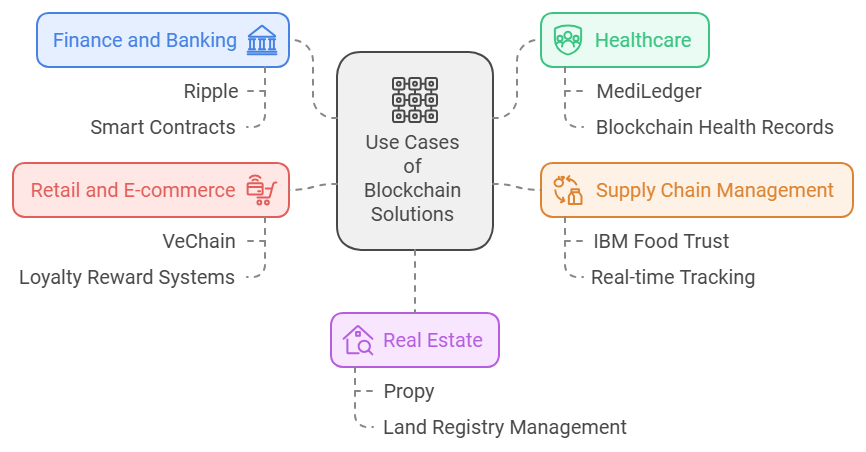
- Finance and Banking: The financial industry was the first to recognize blockchain’s transformative potential, leveraging its capabilities to address inefficiencies in cross-border payments, lending, and fraud detection. Ripple has emerged as a leader in providing real-time, low-cost solutions for cross-border transactions, streamlining processes that were traditionally slow and expensive. Blockchain-enabled smart contracts have introduced automation to financial services, such as loan approvals, eliminating the need for manual intervention.
- Healthcare: Blockchain solutions in healthcare focus on enhancing secure patient data management, improving interoperability, and ensuring pharmaceutical traceability. MediLedger enables secure tracking of the drug supply chain, helping to prevent the circulation of counterfeit medicines. Blockchain-powered health records allow seamless access to patient information across hospitals, ensuring continuity of care and reducing administrative bottlenecks.
- Supply Chain Management: Blockchain ensures end-to-end transparency in supply chain operations, effectively reducing delays and mitigating fraud. IBM Food Trust leverages blockchain technology to enhance food safety by tracing products from farm to table, ensuring authenticity and quality. Real-time tracking of goods in transit allows businesses to improve logistics by providing accurate delivery timelines and reducing inefficiencies.
- Retail and E-commerce: Retailers are increasingly leveraging blockchain technology to authenticate products, manage inventory efficiently, and streamline payment processes. VeChain uses blockchain to verify the authenticity of luxury goods, ensuring consumers receive genuine products. Blockchain-powered loyalty reward systems bring transparency to point allocation, enhancing customer trust and engagement.
- Real Estate: Blockchain simplifies property transactions by digitizing records and automating processes. Propy uses blockchain technology to facilitate property sales, offering a transparent and efficient platform for buyers and sellers. Blockchain-powered land registry management reduces fraud and paperwork, ensuring accurate ownership records and streamlining administrative tasks.
Key Features of a Blockchain Solution
Blockchain solutions offer innovative frameworks to address the evolving demands of modern industries. Below are the key features that define a robust blockchain solution.
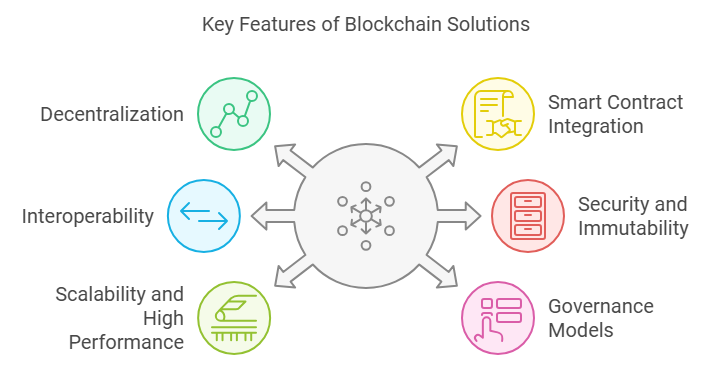
1. Decentralization
Decentralization lies at the heart of blockchain architecture. Unlike centralized systems that rely on a single authority, blockchain operates on a distributed network where data is stored and verified by multiple participants. This decentralized structure eliminates the need for intermediaries, reducing costs and vulnerabilities associated with single points of failure.
2. Smart Contract Integration
Smart contracts automatically trigger predefined actions when specific conditions are met, eliminating the need for manual intervention. Blockchain solutions with smart contract integration streamline workflows, enhance efficiency, and reduce human error. For example, in supply chain management, smart contracts can automatically release payments upon delivery confirmation. Industries such as insurance, real estate, and DeFi are leveraging smart contracts to automate processes and create innovative service models.
3. Interoperability
Interoperability is crucial as industries adopt multiple blockchain platforms to serve diverse needs. Tools like Polkadot, Cosmos, and blockchain bridges enable cross-chain compatibility, ensuring that data and assets can flow freely across networks. Interoperable blockchain solutions foster collaboration, reduce fragmentation and create unified ecosystems, unlocking new opportunities for innovation.
4. Security and Immutability
By using cryptographic techniques such as hashing and digital signatures, blockchain ensures that data is tamper-proof and securely stored. Once data is added to the blockchain, it becomes immutable, meaning it cannot be altered without consensus from the entire network. This feature is particularly critical in industries like finance and healthcare, where safeguarding sensitive information is paramount.
5. Scalability and High Performance
As blockchain adoption grows, scalability becomes a critical feature. Modern blockchain solutions are designed to handle increased transaction volumes without compromising speed or efficiency. Technologies such as Layer 2 scaling solutions and hybrid blockchain models are enabling blockchains to achieve higher throughput and lower latency.
6. Governance Models
Governance defines how decisions are made within a blockchain network, ensuring accountability and transparency. On-chain governance allows stakeholders to vote on changes directly through the blockchain, while off-chain governance relies on external discussions and agreements. Transparent governance processes build trust among participants, fostering collaboration and ensuring the network’s long-term stability.
Why Are Blockchain Solutions A Strong Business Investment?
Investing in blockchain solutions offers enhanced operational efficiency by automating workflows and reducing intermediaries, resulting in cost savings and faster transactions in industries like finance, supply chain, and healthcare. Blockchain ensures transparency and security with an immutable ledger, reducing fraud and increasing trust, especially in sensitive sectors like finance and insurance. Its expanding use cases include applications in supply chain management, decentralized finance, and healthcare, making it versatile and future-proof.
Blockchain generates revenue through licensing fees, transaction charges, and asset tokenization. The technology also integrates with AI, IoT, and cloud computing, unlocking advanced capabilities, while regulatory alignment ensures compliance and global adoption. With the global blockchain market projected to exceed $67 billion by 2027, companies developing blockchain solutions are seeing exponential growth. For instance, IBM, Oracle, and ConsenSys leverage blockchain platforms to generate consistent revenue through enterprise services and SaaS models.
Top Companies Revenues in Blockchain Solutions
| Company | Revenue | Key Offerings |
| IBM Blockchain | $4.6 billion | Enterprise blockchain solutions for supply chains |
| Oracle | $1 billion+ | Blockchain cloud services for data management |
| ConsenSys | $150 million+ | Ethereum-based dApps, MetaMask, and blockchain tools |
| Ripple | $880 million | Cross-border payment solutions with XRP integration |
| VeChain | $600 million+ | Blockchain for supply chain and IoT integration |
Most Successful Business Models of Blockchain Solutions
While the blockchain technology itself is transformative, the success of blockchain solutions heavily depends on the business models driving their adoption and sustainability. Below, we explore the most successful blockchain solution business models.
1. Software-as-a-Service Model
One of the most prominent business models for blockchain solutions is the SaaS model. In this setup, companies provide blockchain-based tools and platforms on a subscription basis. This model is highly scalable and appeals to businesses of all sizes, making blockchain technology accessible and cost-effective.
Businesses can access blockchain solutions without significant upfront investment as service providers handle hosting, updates, and security. Flexible pricing models, including monthly or yearly subscriptions, make it easier for companies to adopt the technology.
Example: IBM Blockchain Platform offers tools for building and scaling blockchain networks, primarily targeting supply chain management and enterprise collaboration.
2. Tokenization and Initial Coin Offerings
The tokenization model involves creating blockchain-based tokens representing assets, services, or rights. These tokens can be traded or used within a specific ecosystem. Tokenization drives innovation, enabling projects to monetize assets while creating liquidity and transparency.
Revenue opportunities include raising capital through ICOs or token sales and charging transaction fees on token exchanges. Tokens can also generate additional revenue by being used in loyalty programs or in-app economies.
Example: Filecoin raised funds through token sales to build a decentralized storage network where users pay with tokens for storage services.
3. Enterprise Blockchain Solutions
Enterprise blockchain solutions cater to businesses seeking private, scalable, and secure networks for managing operations. Providers customize blockchain frameworks to meet specific organizational needs.
Revenue is generated through licensing fees for blockchain infrastructure, ongoing support and updates, and consulting services for implementation. This model ensures consistent income while helping businesses adopt and maintain blockchain solutions.
Example: Hyperledger Fabric is widely used in enterprise settings for applications like supply chain tracking and financial settlements.
4. Transaction Fee-Based Model
In a transaction fee-based model, blockchain solution providers generate revenue by charging small fees for each transaction conducted on their platform. This model works well in high-transaction environments like finance and e-commerce.
Key characteristics include their use in payment gateways, cryptocurrency exchanges, and DeFi applications, with fees charged either as fixed amounts or a percentage of the transaction value. The high volume of transactions ensures consistent revenue generation.
Example: Ripple’s blockchain solution facilitates cross-border payments with minimal transaction fees, making it a preferred choice for financial institutions.
5. Blockchain Infrastructure as a Service
BaaS provides businesses with blockchain infrastructure and tools without requiring them to build systems from scratch. This model is particularly appealing to startups and small businesses.
Revenue generation comes from subscription fees for access to blockchain networks and tools, along with charges for additional features such as analytics and smart contract deployment.
Example: Amazon Web Services offers blockchain infrastructure for building and deploying decentralized applications, making it easy for businesses to adopt blockchain.
6. Decentralized Finance (DeFi) Revenue Models
DeFi applications are blockchain solutions designed to replace traditional financial services like lending, borrowing, and trading. DeFi models are successful due to their transparency, accessibility, and ability to attract significant liquidity. These platforms generate revenue through:
These platforms generate revenue through transaction fees on token swaps or trades, interest rates on loans and savings, and liquidity provision fees in decentralized exchanges.
Example: Aave, a leading DeFi platform, earns through interest differentials and protocol fees, making decentralized lending and borrowing highly efficient.
Steps to Develop A Blockchain Solution
Developing a blockchain solution involves a series of structured steps that ensure its effectiveness, security, and scalability. Below are eight critical steps that will guide you through the process of creating an impactful blockchain solution.
Step 1: Identify the Problem and Define Goals
The first step in developing a blockchain solution is to thoroughly identify the problem it aims to solve. This requires understanding the inefficiencies or challenges present in existing systems, along with recognizing the need for decentralization, transparency, or enhanced security. Focusing on the end-users and their specific requirements is crucial to ensure the solution is targeted and impactful. Defining clear goals and success metrics helps measure progress and determine if the solution effectively addresses the pain points.
Step 2: Choose the Appropriate Blockchain Platform
Choosing the right blockchain platform is essential for ensuring that the solution can meet its objectives efficiently and scale as needed. There are several options to consider. For example, Ethereum is ideal for creating smart contract-based applications, while Hyperledger Fabric is tailored for private blockchain solutions in enterprise settings. Binance Smart Chain focuses on DeFi applications and token-based systems. It’s crucial to evaluate factors such as consensus mechanisms, transaction speed, scalability, and community support to determine which platform aligns best with the solution’s requirements.
Step 3: Design the Blockchain Architecture
Designing the architecture is a key step in determining how the blockchain will operate and how data will be handled. You must decide whether the blockchain will be public, private, or hybrid. Public blockchains are open to all users and are well-suited for transparency-focused solutions. Private blockchains, on the other hand, offer restricted access and are ideal for businesses that prioritize control and privacy. Hybrid models combine elements of both public and private blockchains, offering flexibility. In this step, selecting the right consensus mechanism is vital for ensuring the network’s reliability and security.
Step 4: Develop Smart Contracts
Smart contracts are a critical component of blockchain solutions, as they automate transactions or processes based on predefined conditions, eliminating the need for intermediaries. These self-executing programs are integral to reducing inefficiencies and ensuring that transactions are executed securely. During development, it’s essential to define the logic and rules that will govern the contract’s execution. Languages like Solidity or Chaincode are commonly used to write smart contracts. Before deployment, rigorous testing is required to ensure that smart contracts are secure and free from vulnerabilities, ensuring reliability and safety in blockchain transactions.
Step 5: Focus on Security and Compliance
Blockchain solutions must prioritize security due to the sensitivity of the data they handle. Implementing strong encryption techniques ensures the protection of sensitive information. Access controls based on user roles add another layer of security, limiting access to critical functions based on authorization. Additionally, audit trails should be created to ensure transparency and traceability of all transactions, maintaining accountability within the blockchain. Compliance with relevant industry regulations, such as GDPR, KYC, or AML, is crucial for meeting legal requirements and gaining user trust in the solution.
Step 6: Create a User-Friendly Interface
For a blockchain solution to be successful, it must be easy to use, even for individuals without technical expertise. Designing a user-friendly interface is essential for enhancing user experience and encouraging adoption. Clear and intuitive dashboards should display key metrics, making it easy for users to navigate through complex data and transactions. Features like one-click actions, QR code scanning, and multi-platform support ensure that the solution is accessible and convenient for a wide range of users, fostering engagement and retention.
Step 7: Test the Blockchain Solution
Before launching the blockchain solution, extensive testing must be conducted to ensure that it works as intended. Functional testing validates each feature of the solution, such as the execution of smart contracts and transaction processes. Security testing is crucial to identify any vulnerabilities, so penetration tests should be performed to simulate potential attacks. Performance testing assesses the solution’s scalability under heavy transaction loads. Gathering feedback from stakeholders and pilot users can provide valuable insights to refine the solution and fix any issues before deployment.
Step 8: Deploy and Provide Ongoing Support
Once testing is complete, the blockchain solution is ready for deployment. However, it’s recommended to launch the solution in stages, starting with a soft launch for a limited user base to identify and address any potential issues. After the initial launch, the solution can be expanded to a wider audience. Ongoing support and maintenance are essential to address user concerns, fix bugs, and roll out updates or new features. Continuous monitoring of system performance and security ensures that the blockchain solution remains secure, efficient, and aligned with evolving user needs.
Cost Of Developing A Blockchain Solution
| Component | Details | Cost Range |
| 1. Research and Planning | – Select a blockchain platform (e.g., Ethereum, Solana). | $2,000 – $8,000 |
| – Design smart contracts and ensure regulatory compliance. | ||
| – Conduct security audits. | ||
| 2. Frontend Development | – Design UI/UX for an intuitive interface. | $2,000 – $10,000 |
| – Develop the front end using React, Angular, or similar technologies. | ||
| 3. Backend Development | – Integrate blockchain and set up nodes. | $3,000 – $15,000 |
| – Develop APIs and integrate databases. | ||
| 4. Smart Contract Development | – Write, test, and deploy smart contracts using Solidity or similar languages. | $1,500 – $7,000 |
| 5. Testing and QA | – Conduct unit, integration, and security testing. | $1,500 – $5,000 |
| – Perform user acceptance testing. | ||
| 6. Deployment and Maintenance | – Set up infrastructure and deploy the app. | $1,000 – $5,000 |
| – Provide updates and security patches post-launch. | ||
| Total Cost Range | $10,000 – $100,000 |
Factors Affecting the Cost of Developing a Blockchain Solution
- Blockchain Platform Choice
The platform selected (e.g., Ethereum, Hyperledger, Solana) influences cost based on network fees, development complexity, and scalability requirements. For instance, Ethereum may incur higher gas fees than private blockchains like Hyperledger. - Smart Contract Complexity
The complexity of the smart contracts impacts development time and cost. Advanced smart contracts requiring intricate logic, tokenomics, or multi-signature functionalities will be more expensive to design, test, and deploy. - Integration with Existing Systems
Seamless integration with existing enterprise software, databases, or external APIs requires additional customization, increasing development time and costs. - Scalability and Performance Requirements
Solutions requiring high transaction throughput or large-scale data handling need optimized architecture, which increases the cost of development and infrastructure.
Conclusion
In my opinion, developing a blockchain solution in 2025 involves selecting the right platform, integrating essential features such as smart contracts, security protocols, and regulatory compliance, and ensuring a seamless user experience across the front and back end. The costs of building a blockchain solution can vary based on the complexity of the features and the level of customization required. However, in my opinion, the potential return on investment makes it a valuable endeavor. As blockchain technology continues to evolve, now is the perfect time to start building a future-ready solution that meets your business needs and prepares you for the opportunities ahead. Start your blockchain journey today and position your business at the forefront of innovation in 2025.
Want to Develop A Blockchain Solution?
At Idea Usher, we are committed to helping you develop a customized blockchain solution that drives innovation and enhances operational efficiency. With over 500,000 hours of coding experience in app development, our team has the expertise to build secure, scalable, and future-proof blockchain systems tailored to your specific business needs. Whether you’re looking to integrate blockchain into your existing processes or develop a new decentralized application, we provide end-to-end support, ensuring seamless implementation and long-term success. Let us guide you in unlocking the full potential of blockchain technology for your business.
Work with Ex-MAANG developers to build next-gen apps schedule your consultation now
FAQs
Why is platform selection important for blockchain development?
The platform determines the functionality, scalability, and compatibility of the blockchain solution, impacting its success and performance.
What role do smart contracts play in blockchain solutions?
Smart contracts automate processes based on predefined rules, enhancing efficiency and reducing reliance on intermediaries.
How does interoperability benefit blockchain solutions?
Interoperability enables seamless communication between different blockchains, reducing fragmentation and fostering collaboration across networks.
What role does regulatory compliance play in blockchain solutions?
Regulatory compliance ensures that blockchain solutions adhere to legal standards, simplifying audits and enabling businesses to operate across jurisdictions.
